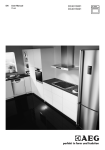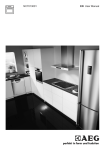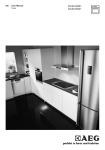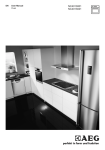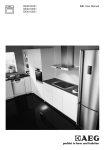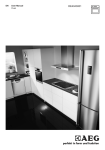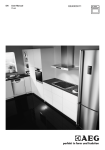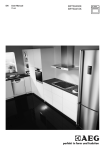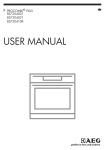Download AEG DC7013001M
Transcript
EN User Manual Oven DC7013001 DC7013021 DC7013101 2 www.aeg.com CONTENTS 1. SAFETY INFORMATION.................................................................................................3 2. SAFETY INSTRUCTIONS................................................................................................ 4 3. PRODUCT DESCRIPTION.............................................................................................. 6 4. CONTROL PANEL...........................................................................................................7 5. BEFORE FIRST USE.........................................................................................................8 6. DAILY USE........................................................................................................................9 7. CLOCK FUNCTIONS.................................................................................................... 11 8. USING THE ACCESSORIES..........................................................................................12 9. ADDITIONAL FUNCTIONS.......................................................................................... 14 10. HINTS AND TIPS......................................................................................................... 15 11. CARE AND CLEANING.............................................................................................. 23 12. TROUBLESHOOTING.................................................................................................26 13. ENERGY EFFICIENCY.................................................................................................27 FOR PERFECT RESULTS Thank you for choosing this AEG product. We have created it to give you impeccable performance for many years, with innovative technologies that help make life simpler features you might not find on ordinary appliances. Please spend a few minutes reading to get the very best from it. Visit our website for: Get usage advice, brochures, trouble shooter, service information: www.aeg.com Register your product for better service: www.registeraeg.com Buy Accessories, Consumables and Original spare parts for your appliance: www.aeg.com/shop CUSTOMER CARE AND SERVICE Always use original spare parts. When contacting our Authorised Service Centre, ensure that you have the following data available: Model, PNC, Serial Number. The information can be found on the rating plate. Warning / Caution-Safety information General information and tips Environmental information Subject to change without notice. ENGLISH 1. 3 SAFETY INFORMATION Before the installation and use of the appliance, carefully read the supplied instructions. The manufacturer is not responsible if an incorrect installation and use causes injuries and damages. Always keep the instructions with the appliance for future reference. 1.1 Children and vulnerable people safety • • • • • • • This appliance can be used by children aged from 8 years and above and persons with reduced physical, sensory or mental capabilities or lack of experience and knowledge if they have been given supervision or instruction concerning use of the appliance in a safe way and understand the hazards involved. Do not let children play with the appliance. Keep all packaging away from children. Keep children and pets away from the appliance when it operates or when it cools down. Accessible parts are hot. If the appliance has a child safety device, we recommend you activate it. Cleaning and user maintenance shall not be made by children without supervision. Children of less than 3 years should be kept away unless continuously supervised. 1.2 General Safety • • • Only a qualified person must install this appliance and replace the cable. Internally the appliance becomes hot when in operation. Do not touch the heating elements that are in the appliance. Always use oven gloves to remove or put in accessories or ovenware. Before maintenance cut the power supply. 4 www.aeg.com • • • • • • Ensure that the appliance is switched off before replacing the lamp to avoid the possibility of electric shock. Do not use a steam cleaner to clean the appliance. Do not use harsh abrasive cleaners or sharp metal scrapers to clean the glass door since they can scratch the surface, which may result in shattering of the glass. If the supply cord is damaged, it must be replaced by the manufacturer, its Authorised Service Centre or similarly qualified persons in order to avoid a hazard. To remove the shelf supports first pull the front of the shelf support and then the rear end away from the side walls. Install the shelf supports in the opposite sequence. The means for disconnection must be incorporated in the fixed wiring in accordance with the wiring rules. 2. SAFETY INSTRUCTIONS 2.1 Installation WARNING! Only a qualified person must install this appliance. • Remove all the packaging. • Do not install or use a damaged appliance. • Obey the installation instruction supplied with the appliance. • Always be careful when you move the appliance because it is heavy. Always wear safety gloves. • Do not pull the appliance by the handle. • Keep the minimum distance from the other appliances and units. • Make sure that the appliance is installed below and adjacent safe structures. • The sides of the appliance must stay adjacent to appliances or to units with the same height. 2.2 Electrical connection WARNING! Risk of fire and electrical shock. • All electrical connections should be made by a qualified electrician. • The appliance must be earthed. • Make sure that the electrical information on the rating plate agrees with the power supply. If not, contact an electrician. • Always use a correctly installed shockproof socket. • Do not use multi-plug adapters and extension cables. • Make sure not to cause damage to the mains plug and to the mains cable. Should the mains cable need to be replaced, this must be carried out by our Authorised Service Centre. • Do not let mains cables touch or come near the appliance door, especially when the door is hot. • The shock protection of live and insulated parts must be fastened in such a way that it cannot be removed without tools. ENGLISH • Connect the mains plug to the mains socket only at the end of the installation. Make sure that there is access to the mains plug after the installation. • If the mains socket is loose, do not connect the mains plug. • Do not pull the mains cable to disconnect the appliance. Always pull the mains plug. • Use only correct isolation devices: line protecting cut-outs, fuses (screw type fuses removed from the holder), earth leakage trips and contactors. • The electrical installation must have an isolation device which lets you disconnect the appliance from the mains at all poles. The isolation device must have a contact opening width of minimum 3 mm. • This appliance complies with the E.E.C. Directives. 2.3 Use WARNING! Risk of injury, burns and electrical shock or explosion. • Use this appliance in a household only. • Do not change the specification of this appliance. • Make sure that the ventilation openings are not blocked. • Do not let the appliance stay unattended during operation. • Deactivate the appliance after each use. • Be careful when you open the appliance door while the appliance is in operation. Hot air can release. • Do not operate the appliance with wet hands or when it has contact with water. • Do not apply pressure on the open door. • Do not use the appliance as a work surface or as a storage surface. • Open the appliance door carefully. The use of ingredients with alcohol can cause a mixture of alcohol and air. • Do not let sparks or open flames to come in contact with the appliance when you open the door. 5 • Do not put flammable products or items that are wet with flammable products in, near or on the appliance. WARNING! Risk of damage to the appliance. • To prevent damage or discoloration to the enamel: – do not put ovenware or other objects in the appliance directly on the bottom. – do not put aluminium foil directly on the bottom of the appliance. – do not put water directly into the hot appliance. – do not keep moist dishes and food in the appliance after you finish the cooking. – be careful when you remove or install the accessories. • Discoloration of the enamel has no effect on the performance of the appliance. It is not a defect in the sense of the warranty law. • Use a deep pan for moist cakes. Fruit juices cause stains that can be permanent. • This appliance is for cooking purposes only. It must not be used for other purposes, for example room heating. • Always cook with the oven door closed. • If the appliance is installed behind a furniture panel (e.g. a door) make sure the door is never closed when the appliance is in operation. Heat and moisture can build up behind a closed furniture panel and cause subsequent damage to the appliance, the housing unit or the floor. Do not close the furniture panel until the appliance has cooled down completely after use. 2.4 Care and cleaning WARNING! Risk of injury, fire, or damage to the appliance. • Before maintenance, deactivate the appliance and disconnect the mains plug from the mains socket. 6 www.aeg.com • Make sure the appliance is cold. There is the risk that the glass panels can break. • Replace immediately the door glass panels when they are damaged. Contact the Authorised Service Centre. • Be careful when you remove the door from the appliance. The door is heavy! • Clean regularly the appliance to prevent the deterioration of the surface material. • Remaining fat or food in the appliance can cause fire. • Clean the appliance with a moist soft cloth. Only use neutral detergents. Do not use abrasive products, abrasive cleaning pads, solvents or metal objects. • If you use an oven spray, obey the safety instructions on the packaging. • Do not clean the catalytic enamel (if applicable) with any kind of detergent. 2.5 Internal light for household appliances. Do not use it for house lighting. WARNING! Risk of electrical shock. • Before replacing the lamp, disconnect the appliance from the power supply. • Only use lamps with the same specifications. 2.6 Disposal WARNING! Risk of injury or suffocation. • Disconnect the appliance from the mains supply. • Cut off the mains cable and discard it. • Remove the door catch to prevent children and pets to get closed in the appliance. 2.7 Service • To repair the appliance contact an Authorised Service Centre. • Use original spare parts only. • The type of light bulb or halogen lamp used for this appliance is only 3. PRODUCT DESCRIPTION 3.1 General overview 1 2 3 7 4 3 2 1 4 5 6 3 5 4 7 3 2 1 4 5 6 1 2 3 4 5 6 7 Control panel Electronic programmer Heating element Lamp Fan Shelf support, removable Shelf positions ENGLISH 3.2 Accessories For roasting and grilling. Use the trivet only with the Grill- / roasting pan. • Telescopic runners For shelves and trays. • Wire shelf For cookware, cake tins, roasts. • Grill- / Roasting pan To bake and roast or as pan to collect fat. • Trivet 4. CONTROL PANEL 4.1 Electronic programmer 1 8 Sensor Field 1 2 3 4 5 6 7 8 - 7 6 5 4 3 2 Function Description DISPLAY Shows the current settings of the appliance. CLOCK To set the clock functions. INCREASE To set the value for the temperature and time. DECREASE To set the value for the temperature and time. FAST HEAT UP To turn the Fast heat up function ON or OFF. DOWN To move down in the menu. OVEN SELECTION To switch between top and main oven. ON / OFF To activate and deactivate the appliance. 7 8 www.aeg.com 4.2 Indicators on the display A 1 B 2 C Name D 4 E F G Description A Top / Main oven indica- Shows which oven operates. tor B Oven function indicator Shows the function which is active. C Lamp / Defrost indicator Shows that the Lamp / Defrost function is active. D Heat-up and residual heat indicator Shows that the Heat-up / residual heat is active. E Temperature / Clock in- Shows the temperature and the time in minutes. dicator F Keep warm indicator Shows that keep warm function is active. Cooking time / End time / Period of operation Shows the time setting for clock functions. G H Clock function indicators Shows the clock function which is active. 4.3 Heat-up indicator When you activate an oven function, the bars on the display come on one by one. The bars show that the oven temperature increases. 5. BEFORE FIRST USE WARNING! Refer to Safety chapters. 5.1 Initial Cleaning Remove all accessories and removable shelf supports from the appliance. Refer to "Care and cleaning" chapter. H Clean the appliance before first use. Put the accessories and the removable shelf supports back to their initial position. 5.2 Setting the time You must set the time before you operate the oven. ENGLISH 9 When you connect the appliance to the electrical supply or after a power cut, the indicator for the Time function flashes. 1. Set the function and the temperature to 250ºC. Let the appliance operate for 1 hour. Press the or to set the correct time. After approximately five seconds, the flashing stops and the display shows the time of day you set. You can only change the time if: 2. Set the function and the temperature to 250ºC. Let the appliance operate for 15 minutes. • The child safety device is not on. • None of the clock functions Duration or End is set. • No oven function is set. 5.3 Preheating 3. Set the function and the temperature to 250ºC. Let the appliance operate for 15 minutes. Accessories can become hotter than usual. The appliance can emit an odour and smoke. This is normal. Make sure that the airflow is sufficient. Preheat the empty appliance to burn off the remaining grease. Preheat the two ovens. Heat up one oven at a time. Set the functions listed below, if applicable. 6. DAILY USE 2. Repeatedly press until the top / main oven indicator appears on the display. WARNING! Refer to Safety chapters. 6.1 Selecting an oven 1. To switch on the appliance press . 6.2 Top oven functions Symbol Oven function Application Light To activate the lamp without a cooking function. True Fan Cooking To bake on 1 shelf position and to dry food. Pizza Setting To bake food on 1 shelf position for a more intensive browning and a crispy bottom. Slow Cooking To prepare tender, succulent roasts. Turbo Grilling To roast larger meat joints or poultry with bones on 1 shelf position. Also to make gratins and to brown. 10 www.aeg.com Symbol CATA Oven function Application Fast Grilling To grill flat food in large quantities and to toast bread. Grilling To grill flat food and to toast bread. Defrost To defrost frozen food. Bottom Heat To bake cakes with crispy bottom and to preserve food. Catalysis To help the self-cleaning catalytic oven layer. 6.3 Main oven functions Symbol Oven function Application Light To activate the lamp without a cooking function. True Fan Cooking To bake on up to 3 shelf positions at the same time and to dry food. Set the temperature 20 - 40 °C lower than for Conventional Cooking. Pizza Setting To bake food on 1 shelf position for a more intensive browning and a crispy bottom. Set the temperature 20 - 40 °C lower than for Conventional Cooking. Slow Cooking To prepare tender, succulent roasts. Conventional Cooking To bake and roast food on 1 shelf position. Turbo Grilling To roast larger meat joints or poultry with bones on 1 shelf position. Also to make gratins and to brown. Fast Grilling To grill flat food in large quantities and to toast bread. Grilling To grill flat food and to toast bread. Keep Warm To keep food warm. Defrost To defrost frozen food. ENGLISH Symbol CATA Oven function Application Bottom Heat To bake cakes with crispy bottom and to preserve food. Catalysis To help the self-cleaning catalytic oven layer. 6.4 Setting the oven function You can change the oven function while the oven operates. Press to set an oven function. The display shows the recommended temperature. If you do not change the this temperature in less than approximately 5 seconds, the appliance starts to heat. 6.5 Changing the oven temperature 11 When the appliance is at the set temperature, an acoustic signal sounds. 6.6 Deactivating the oven function Press until no oven function shows in the display. 6.7 Residual heat indicator When you deactivate the oven, the display shows the residual heat. Press or to change the temperature. 7. CLOCK FUNCTIONS 7.1 Clock functions table Clock function Application Time of day To set, change or check the time of day. Minute Minder To set countdown time. This function has no effect on the operation of the appliance. Duration To set the cooking time of the oven. End To set the time of day when the oven should deactivate. 12 www.aeg.com You can use the functions Duration and End at the same time to set the time for how long the appliance should operate and when the appliance should deactivate. This lets you activate the appliance with a delay in time. First set the Duration the End and then . 7.2 Setting the clock functions For Duration and End set the oven function and temperature. This is not necessary for the Minute Minder . Refer to "Setting an oven function". 1. Use again and again until the display shows the necessary clock function. 2. Use or to set the necessary time. The clock function operates. The display shows the indicator for the clock function you set. When the time ends the indicator of the clock function and “00.00” flash and an acoustic signal sounds for 2 minutes. The appliance deactivates. Touch a sensor field to stop the acoustic signal. With Duration and End , the oven deactivates automatically. 8. USING THE ACCESSORIES WARNING! Refer to Safety chapters. 8.1 Inserting the accessories Wire shelf: Push the shelf between the guide bars of the shelf support and make sure that the feet point down. Wire shelf and the deep pan together: Push the deep pan between the guide bars of the shelf support and the wire shelf on the guide bars above. Deep pan: Push the deep pan between the guide bars of the shelf support. ENGLISH • All accessories have small indentations at the top of the right and left side to increase safety. The indentations are also antitip devices. • The high rim around the shelf is a device which prevents cookware from slipping. 8.2 Telescopic runners inserting the accessories 13 Wire shelf and deep pan together: Put the wire shelf on the deep pan. Put the wire shelf and the deep pan on the telescopic runners. CAUTION! Make sure you push back the telescopic runners fully in the appliance before you close the oven door. Wire shelf: Put the wire shelf on the telescopic runners so that the feet point downwards. The high rim around the wire shelf is a special device to prevent the cookware from slipping. 8.3 Trivet and Grill- / Roasting pan WARNING! Be careful when you remove the accessories from a hot appliance. There is a risk of burns. You can use the trivet to roast larger pieces of meat or poultry on one shelf position. Baking tray or deep pan: 1. Put the trivet into the deep pan so that the supports of the wire shelf point up. Put the baking tray or deep pan on the telescopic runners. 2. Put the deep pan into the oven on the necessary shelf position. 14 www.aeg.com You can use the trivet to grill flat dishes in large quantities and to toast. 2. Put the deep pan into the oven on the necessary shelf position. 1. Put the trivet into the deep pan so that the supports of the wire shelf point down. 9. ADDITIONAL FUNCTIONS 9.1 Using the Child Lock 9.3 Oven automatic switch-off The Child Lock prevents an accidental operation of the appliance. For safety reasons the appliance deactivates automatically after some time if a heating function operates and you do not change any settings. 1. To activate the function activate the appliance with oven function. . Do not set an and at the 2. Touch and hold same time for 2 seconds. SAFE comes on in the display. To deactivate the Child Lock function repeat step 2. 9.2 Using the Function Lock You can activate the function only when the oven operates. The Function Lock prevents an accidental change of the oven function. 1. Activate the oven. 2. Set the oven function. and at the same time, 3. Press until “LOC” comes on the display. To deactivate the Function Lock press and at the same time, until the display stops to show "LOC". You can deactivate the oven when the Function Lock is on. When you deactivate the oven, the Function Lock deactivates. Temperature Switch-off time 30 °C - 115 °C 12.5 h 120 °C - 195 °C 8.5 h 200 °C - 245 °C 5.5 h 250 °C - maximum °C 3.0 h After the Automatic switch-off, press a sensor field to operate the appliance again. The oven automatic switchoff does not work with the Duration or End function. 9.4 Cooling fan When the appliance operates, the cooling fan activates automatically to keep the surfaces of the appliance cool. If you deactivate the appliance, the cooling fan can continue to operate until the appliance cools down. ENGLISH 15 10. HINTS AND TIPS WARNING! Refer to Safety chapters. The temperature and baking times in the tables are guidelines only. They depend on the recipes and the quality and quantity of the ingredients used. 10.1 Double oven Top oven The top oven is the smaller of the two ovens. It has 4 shelf positions. Use it to cook smaller quantities of food. It gives especially good results when used to cook fruitcakes, sweets and savoury flants or quiche. Main oven The main oven is the bigger of the two ovens. It is particularly suitable for cooking larger quantities of food. 10.2 Baking • Your oven can bake or roast differently to the appliance you had before. Adapt your usual settings (temperature, cooking times) and shelf positions to the values in the tables. • The manufacturer recommends that you use the lower temperature the first time. • If you cannot find the settings for a special recipe, look for the one that is almost the same. • You can extend baking times by 10 – 15 minutes if you bake cakes on more than one shelf position. • Cakes and pastries at different heights do not always brown equally at first. If this occurs, do not change the temperature setting. The differences equalize during the baking procedure. • With longer baking times, you can deactivate the oven approximately 10 minutes before the end of the baking time and then use the residual heat. When you cook frozen food, the trays in the oven can twist during baking. When the trays become cold again, the distortions are gone. 10.3 Tips on baking Baking results Possible cause Remedy The bottom of the cake is not browned sufficiently. The shelf position is incorrect. Put the cake on a lower shelf. The cake sinks and becomes The oven temperature is too The next time you bake, set soggy, lumpy or streaky. high. a slightly lower oven temperature. The cake sinks and becomes The baking time is too short. Set a longer baking time. soggy, lumpy or streaky. You cannot decrease baking times by setting higher temperatures. The cake sinks and becomes There is too much liquid in soggy, lumpy or streaky. the mixture. The cake is too dry. Use less liquid. Be careful with mixing times, especially if you use a mixing machine. The oven temperature is too The next time you bake, set low. a higher oven temperature. 16 www.aeg.com Baking results Possible cause Remedy The cake is too dry. The baking time is too long. The next time you bake, set a shorter baking time. The cake browns unevenly. The oven temperature is too Set a lower oven temperahigh and the baking time is ture and a longer baking too short. time. The cake browns unevenly. The mixture is unevenly distributed. The cake is not ready in the baking time given. The oven temperature is too The next time you bake, set low. a slightly higher oven temperature. Spread the mixture evenly on the baking tray. 10.4 Baking Top oven Food Temperature (°C) Time (min) Shelf position Biscuits 170 - 190 10 - 20 2 Bread 200 - 220 30 - 35 1 Bread rolls / buns 170-180 10 - 15 1 - Small & Queen 160 - 170 18 - 25 2 - Sponges 160 - 175 20 - 30 2 - Victoria Sandwich 160 - 170 18 - 25 2 - Madeira 140 - 150 75 - 90 2 - Rich Fruit 140 - 150 120 - 150 2 - Gingerbread 140 - 150 75 - 90 2 - Meringues 90 - 100 150 - 180 2 - Flapjack 160 - 170 25 - 30 2 - Shortbread 130 - 150 45 - 65 2 - Beef / Lamb 160 - 170 150 - 180 1 - Chicken 160 - 180 75 - 90 1 Convenience Foods Follow manufacturer's instructions. Fish 170 - 190 20 - 30 2 Fish Pie (Potato Topped) 190 - 200 20 - 30 2 Cakes: Casseroles: ENGLISH Food Temperature (°C) Time (min) Shelf position Fruit Pies, Crumbles 190 - 200 30 - 50 2 Milk Puddings 150 - 170 90 - 120 2 Pasta, Lasagne etc. 170 - 180 40 - 50 2 - Choux 180 - 190 30 - 40 2 - Eclairs, Profiteroles 180 - 190 30 - 40 2 - Flaky / Puff Pies 210 - 220 30 - 40 2 - Mince Pies 190 - 210 15 - 20 2 - Meat Pies 190 - 210 25 - 35 2 - Quiche, Tarts, Flans 180 - 200 25 - 50 2 Scones 220 - 230 8 - 12 2 Shepard's Pie 180 - 190 30 - 40 2 Souffles 190 - 200 20 - 30 2 - Baked Jacket Potatoes 180 - 190 60 - 90 2 - Roast Potatoes 180 - 190 60 - 90 2 - Large 200 - 210 25 - 40 1 - Individual 210 - 220 15 - 25 1 Pastry: Shortcrust: Vegetables: Yorkshire Pudding: Main oven Food Temperature (°C) Time (min) Shelf position Conventional Cooking True Fan Cooking Biscuits 180 - 190 180 - 190 10 - 20 2 Bread 200 - 220 190 - 210 30 - 35 2 - Small & Queen 170 - 180 160 - 170 18 - 25 2 - Sponges 170 - 180 160 - 170 20 - 25 2 - Madeira 150 - 160 140 - 160 60 - 75 2 - Rich Fruit 140 - 150 130 - 140 120 - 150 2 Cakes: 17 18 www.aeg.com Food Temperature (°C) Time (min) Shelf position Conventional Cooking True Fan Cooking - Christmas 140 - 150 130 - 140 180 - 270 2 Fish 170 - 180 160 - 180 20 - 30 3 Fruit Pies, Crumbles 180 - 200 170 - 180 30 - 50 3 Milk Puddings 150 - 170 140 - 160 60 - 90 3 - Choux 180 - 190 180 - 190 30 - 40 3 - Shortcrust 190 - 200 180 - 190 25 - 35 3 - Flaky 190 - 210 180 - 190 30 - 40 3 - Puff Follow manufacturer's instructions. Reduce the temperature by 20ºC for True Fan Cooking Function. Plate Tarts 190 - 200 180 - 190 25 - 45 3 Quiches / Flans 200 - 210 170 - 180 25 - 45 3 Scones 220 - 230 210 - 230 8 - 12 2 Pastry: 10.5 Slow Cooking Use this function to prepare lean, tender pieces of meat and fish. This function is not applicable to such recipes as pot roast or fatty roast pork. In the first 10 minutes you can set an oven temperature between 80 °C and 150 °C. The default is 90 °C. After the temperature is set, the oven continues to cook at 80 °C. Do not use this function for poultry. Always cook without a lid when you use this function. 1. Sear the meat in a pan on the hob on a very high setting for 1 - 2 minutes on each side. 2. Put the meat together with the hot roasting pan into the oven on the wire shelf. 3. Select the function Slow Cooking. Food Quantity Temperature (°C) Time (min) Shelf position Roast beef 1000 - 1500 g 120 120 - 150 1 Fillet of beef 1000 - 1500 g 120 90 - 150 3 Roast veal 1000 - 1500 g 120 120 - 150 1 Steaks 200 - 300 g 120 20 - 40 3 ENGLISH 19 10.6 Pizza Setting Top oven Food Temperature (°C) Time (min) Shelf position Apple Pie 160 - 180 160 - 180 1 Plate Tart 160 - 180 25 - 50 1 Pizza Follow manufacturer's instructions. 1 Quiches / Tarts 160 - 180 25 - 50 1 Food Temperature (°C) Time (min) Shelf position Apple Pie 160 - 180 50 - 60 3 Plate Tart 180 - 200 25 - 50 3 Pizza Follow manufacturer's instructions. 3 Quiches / Tarts 180 - 200 3 Main oven 25 - 50 10.7 Roasting • Use heat-resistant ovenware to roast (refer to the instructions of the manufacturer). • You can roast large roasting joints directly in the deep pan (if present) or on the wire shelf above the deep pan. • Roast lean meats in the roasting tin with the lid. This keeps the meat more succulent. • All types of meat that can be browned or have crackling can be roasted in the roasting tin without the lid. • We recommend that you cook meat and fish weighing 1 kg and above in the appliance. • To prevent the meat juices or fat from burning onto the pan, put some liquid into the deep pan. • If necessary, turn the roast (after 1/2 2/3 of the cooking time). • Baste large roasts and poultry with their juices several times during roasting. This gives better roasting results. • You can deactivate the appliance approximately 10 minutes before the end of the roasting time, and use the residual heat. 10.8 Roasting tables - Main oven Beef Food Quantity Temperature (°C) Time (min) Shelf position Roast beef or fillet: rare per cm. of thickness 190 - 2001) 5-6 2 Roast beef or fillet: medium per cm. of thickness 180 - 1901) 6-8 2 20 www.aeg.com Food Quantity Temperature (°C) Time (min) Shelf position Roast beef or fillet: well done per cm. of thickness 170 - 1801) 8 - 10 2 Food Quantity Temperature (°C) Time (min) Shelf position Shoulder, neck, ham 1 - 1.5 kg 160 - 180 90 - 120 2 Pork chop 1 - 1.5 kg 160 - 180 60 - 90 2 Meat loaf 750 g - 1 kg 160 - 170 45 - 60 2 Knuckle of pork (precooked) 750 g - 1 kg 150 - 170 90 - 120 2 1) Preheat the oven. Pork Veal Food Quantity (kg) Temperature (°C) Time (min) Shelf position Roast veal 1 160 - 180 90 - 120 2 Knuckle of veal 1.5 - 2 160 - 180 120 - 150 2 Food Quantity (kg) Temperature (°C) Time (min) Shelf position Leg of lamb, roast lamb 1 - 1.5 150 - 170 75 - 120 2 Saddle of lamb 1 - 1.5 160 - 180 60 - 90 2 Food Quantity (kg) Temperature (°C) Time (min) Shelf position Saddle of hare, leg of hare Up to 1 kg 220-250 25 - 40 2 Loin of Game 1.5-2 210-220 75 - 105 1 Leg of Game 1.5-2 200-210 90 - 135 1 Lamb Game ENGLISH 21 Poultry Food Quantity Poultry pieces Temperature (°C) Time (min) Shelf position 200 - 250 g each 200 - 220 35 - 50 3 Half chicken 400 - 500 g each 190 - 210 35 - 50 3 Poultry 1 - 1.5 kg 190 - 210 45 - 75 1 Duck 1.5 - 2 kg 180 - 200 75 - 100 1 Goose 3.5 - 5 kg 160 - 180 150 - 210 1 Turkey 2.5 - 3.5 kg 160 - 180 105 - 150 1 Turkey 4 - 6 kg 140 - 160 150 - 240 1 Type of meat Quantity (kg) Temperature (°C) Time (min) Shelf position Whole fish 1 - 1.5 210 - 220 40 - 60 1 Fish (steamed) 10.9 Grilling Grill only flat pieces of meat or fish. Always grill with the maximum temperature setting. Always preheat the empty oven with the grill functions for 5 minutes. CAUTION! Always grill with the oven door closed. Set the shelf into the shelf position as recommended in the grilling table. For grilling in the top oven adjust the shelf position to suit different thicknesses of food. Always set the pan to collect the fat into the first shelf position. Grilling and Fast Grilling - Top oven Food Time (min) Bacon Rashers 5 -6 Beefburgers 10 - 20 Chicken Joints 20 - 40 Lamb Chops 15 - 25 Pork Chops 20 - 25 Whole Fish, Trout / Makarel 10 - 12 Fillets, Plaice / Cod 4-6 Kebabs 12 - 18 Kidneys, Lamb / Pig 6 - 10 22 www.aeg.com Food Time (min) Sausages 20 - 30 Toasted Sandwiches 3-4 Steaks: - Rare 4-6 - Medium 6-8 - Well Done 12 - 15 Grilling - Main oven Food Temperature (°C) Time (min) Shelf position 1st side 2nd side Roast beef 210 - 230 30 - 40 30 - 40 2 Filet of beef 230 20 - 30 20 - 30 3 Back of pork 210 - 230 30 - 40 30 - 40 2 Back of veal 210 - 230 30 - 40 30 - 40 2 Back of lamb 210 - 230 25 - 35 20 - 25 3 Whole Fish, 500 - 1000 g 210 - 230 15 - 30 15 - 30 3/4 Fast Grilling - Main oven Food Time (min) Shelf position 1st side 2nd side Burgers / Burgers 8 - 10 6-8 4 Pork fillet 10 - 12 6 - 10 4 Sausages 10 - 12 6-8 4 Fillet / Veal steaks 7 - 10 6-8 4 Toast / Toast 1) 1-3 1-3 5 Toast with topping 6-8 - 4 1) Preheat the oven. 10.10 Defrost - Main oven Remove the food packaging and put the food on a plate. Use the first shelf position from the bottom. Do not cover the food with a bowl or a plate, as this can extend the defrost time. ENGLISH 23 Food Quantity Defrosting time (min) Further deComments frosting time (min) Chicken 1 kg 100 - 140 20 - 30 Put the chicken on an upturned saucer in a big plate. Turn halfway through. Meat 1 kg 100 - 140 20 - 30 Turn halfway through. Meat 500 g 90 - 120 20 - 30 Turn halfway through. Trout 150 g 25 - 35 10 - 15 - Strawber- 300 g ries 30 - 40 10 - 20 - Butter 250 g 30 - 40 10 - 15 - Cream 2 x 200 g 80 - 100 10 - 15 Whip the cream when still slightly frozen in places. Gateau 1.4 kg 60 60 - 11. CARE AND CLEANING WARNING! Refer to Safety chapters. 11.1 Notes on cleaning • Clean the front of the appliance with a soft cloth with warm water and a cleaning agent. • To clean metal surfaces, use a usual cleaning agent. • Clean the appliance interior after each use. Fat accumulation or other food remains may result in a fire. The risk is higher for the grill pan. • Clean stubborn dirt with a special oven cleaner. • Clean all accessories after each use and let them dry. Use a soft cloth with warm water and a cleaning agent. • If you have nonstick accessories, do not clean them using aggressive agents, sharp-edged objects or a dishwasher. It can cause damage to the nonstick coating. 11.2 Stainless steel or aluminium appliances Clean the oven door with a wet sponge only. Dry it with a soft cloth. Do not use steel wool, acids or abrasive materials as they can damage the oven surface. Clean the oven control panel with the same precautions. 11.3 Removing the shelf supports To clean the oven, remove the shelf supports. 1. Pull the front of the shelf support away from the side wall. 24 www.aeg.com Before activating the catalytic cleaning remove all the accessories from the oven. 2. Pull the rear end of the shelf support away from the side wall and remove it. 2 1 Install the shelf supports in the opposite sequence. The retaining pins on the telescopic runners must point to the front. 11.4 Catalytic cleaning CAUTION! Do not clean the catalytic surface with oven sprays, abrasive cleaning agents, soap or other cleaning agents. This will damage the catalytic surface. Spots or discolouration of the catalytic surface have no effect on catalytic properties. WARNING! Keep children away when you clean the oven at a high temperature. The oven surface becomes very hot and there is a risk of burns. CAUTION! Always turn the oven light on while using the catalytic cleaning (if applicable). The walls with a catalytic coating are selfcleaning. They absorb fat which collects on the walls while the appliance operates. To support the self-cleaning procedure, heat the empty oven on a regular basis. 1. Clean the oven floor with warm water and washing up liquid, then dry it. 2. Set the CATA function. Oven will switch off after one hour. 3. When the appliance is cool, clean it with a soft and moist sponge. 11.5 Removing and installing the door You can remove the door and the internal glass panels to clean it. The number of glass panels is different for different models. WARNING! Be careful when you remove the door from the appliance. The door is heavy. 1. Open the door fully. 2. Fully lift up the clamping levers (A) on the two door hinges. A A 3. Close the door until it is at an angle of approximately 45°. ENGLISH 25 When the cleaning is completed, install the glass panels and the door. Do the above steps in the opposite sequence. Install the smaller panel first, then the larger. 11.6 Replacing the lamp Put a cloth on the bottom of the interior of the appliance. It prevents damage to the lamp glass cover and the cavity. 45° 4. Hold the door with one hand on each side and pull it away from the appliance at an upwards angle. 5. Put the door with the outer side down on a soft cloth on a stable surface. This is to prevent scratches. 6. Hold the door trim (B) on the top edge of the door at the two sides and push inwards to release the clip seal. WARNING! Danger of electrocution! Disconnect the fuse before you replace the lamp. The lamp and the lamp glass cover can be hot. 1. Deactivate the appliance. 2. Remove the fuses from the fuse box or deactivate the circuit breaker. The back lamp The lamp glass cover is at the back of the cavity. 2 B 1 CAUTION! Rough handling of the glass, especially around the edges of the front panel, can cause the glass to break. 7. Pull the door trim to the front to remove it. 8. Hold the door glass panels on their top edge one by one and pull them up out of the guide. 9. Clean the glass panel with water and soap. Dry the glass panel carefully. 1. Turn the lamp glass cover counterclockwise to remove it. 2. Clean the glass cover. 3. Replace the oven lamp with a suitable 300 °C heat-resistant oven lamp. Use the same oven lamp type. 4. Install the glass cover. The side lamp 1. Remove the left shelf support to get access to the lamp. 2. Use a narrow, blunt object (e.g. a teaspoon) to remove the glass cover. 26 www.aeg.com 3. Clean the glass cover. 4. Replace the lamp with a suitable 300 °C heat-resistant lamp. 5. Install the glass cover. 6. Install the left shelf support. 12. TROUBLESHOOTING WARNING! Refer to Safety chapters. 12.1 What to do if... Problem Possible cause Remedy The oven does not heat up. The oven is deactivated. Activate the oven. The oven does not heat up. The clock is not set. Set the clock. The oven does not heat up. The necessary settings are not set. Make sure that the settings are correct. The oven does not heat up. The automatic switch-off is activated. Refer to "Automatic switchoff". The oven does not heat up. The Child Lock is on. Refer to "Using the Child Lock". The oven does not heat up. The fuse is released. Make sure that the fuse is the cause of the malfunction. If the fuse releases again and again, contact a qualified electrician. The lamp does not operate. The lamp is defective. Replace the lamp. It takes too long to cook the dishes or they cook too quickly. The temperature is too low or too high. Adjust the temperature if necessary. Follow the advice in the user manual. Steam and condensation You left the dish in the oven settle on the food and in the for too long. cavity of the oven. Do not leave the dishes in the oven for longer than 15 20 minutes after the cooking process ends. ENGLISH 27 Problem Possible cause Remedy The display shows an error code that is not in this table. There is an electrical fault. • Deactivate the oven with the house fuse or the safety switch in the fuse box and activate it again. • If the display shows the error code again, contact the Customer Care Department. 12.2 Service data If you cannot find a solution to the problem yourself, contact your dealer or an Authorised Service Centre. on the front frame of the appliance cavity. Do not remove the rating plate from the appliance cavity. The necessary data for the service centre is on the rating plate. The rating plate is We recommend that you write the data here: Model (MOD.) ......................................... Product number (PNC) ......................................... Serial number (S.N.) ......................................... 13. ENERGY EFFICIENCY 13.1 Product Fiche and information according to EU 65-66/2014 Supplier's name AEG Model identification DC7013001M DC7013021M DC7013101M Energy Efficiency Index Top oven: 105.6 Main oven: 106.2 Energy efficiency class Top oven: A Main oven: A Energy consumption with a standard load, conventional mode Top oven: not applicable Main oven: 0.92 kWh/cycle Energy consumption with a standard load, fan-forced Top oven: 0.75 kWh/cycle mode Main oven: 0.86 kWh/cycle Number of cavities 2 Heat source Electricity 28 www.aeg.com Volume Top oven: 39 l Main oven: 62 l Type of oven Built-In Oven Mass EN 60350-1 - Household electric cooking appliances - Part 1: Ranges, ovens, steam ovens and grills - Methods for measuring performance. 13.2 Energy saving The appliance contains features which help you save energy during everyday cooking. • General hints – Make sure that the oven door is closed properly when the appliance operates and keep it closed as much as possible during the cooking. – Use metal dishes to improve the energy saving. – When possible, put the food inside the oven without heating it up. – When the cooking duration is longer than 30 minutes, reduce the oven temperature to DC7013001M 57.7 kg DC7013021M 59.0 kg DC7013101M 56.7 kg minimum, 3 - 10 minutes before the end of the cooking time, depending on the duration of the cooking. The residual heat inside the oven will continue to cook. – Use the residual heat to warm up other foods. • Cooking with fan - when possible, use the cooking functions with fan to save energy. • Residual heat – In some oven functions if a programme with time selection (Duration, End) is activated and the cooking time is longer than 30 minutes, the heating elements deactivate automatically 10% earlier. The fan and lamp continue to operate. • Keep food warm - if you want to use the residual heat to keep the meal warm, choose the lowest possible temperature setting. The display shows the residual heat temperature. 14. ENVIRONMENT CONCERNS Recycle the materials with the symbol . Put the packaging in applicable containers to recycle it. Help protect the environment and human health and to recycle waste of electrical and electronic appliances. Do not dispose appliances * marked with the symbol with the household waste. Return the product to your local recycling facility or contact your municipal office. ENGLISH 29 30 www.aeg.com ENGLISH 31 867300174-A-452014 www.aeg.com/shop
































